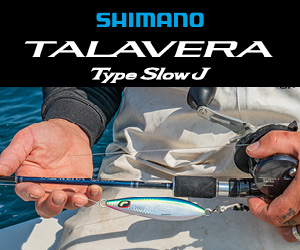With a band of heavy showers on the radar and black clouds sweeping eastward from behind Atlantic City, it was looking like a tough day to deploy reef materials. But with a tug called the Justin already twenty-some hours into its northern trip from Norfolk, VA towards South Jersey’s artificial reef complex, there was no time to turn back now.
Captained by Steve Evert, Stockton University’s 36-foot research vessel, the R/V Petrel, headed SE out of Absecon Inlet at about 7 a.m. on Thursday, June 16 on a course set for N39 09.993/W74 34.095, the precise spot where a dredge being towed behind the Justin would soon be deployed on the Ocean City Reef site.
Also breaking Absecon Inlet to greet the tow crew was a 24-foot Parker piloted by Billy Maxwell with New Jersey’s Department of Environmental Protection (NJDEP) along with fellow reef deployment staffers Hugh Carberry and Peter Clark.
At 80 feet in length and 15 feet in height, the new dredge sits bow to stern roughly NE by SW at a position approximately 7.4 miles SE of Great Egg Inlet and, should soon become a home for 150 species of fish and marine life. The dredge deployment was funded with support from the Strathmere Fishing and Environmental Club, the Ann E. Clark Foundation and the Sportfishing Fund. Once the hold was filled by water and the “soft patches” installed in Norfolk banged out by sledgehammer by crew from Coleen Marine who was contracted for the deployment, the dredge sank in a matter of minutes.
The Justin then steamed NE towards Atlantic City Reef approximately 8.8 miles east of Absecon Inlet with the second of the two towed deployment vessels, a large, red tug (formally known as the Tobacco Pointe when in service back in Virginia) bound for its new home at the Atlantic City Reef (N39 14.0381 W74 12.5675). Officially re-christened in honor of The Fisherman Magazine’s founder, Richard Reina, the 95-foot long tug immediately showed up on Stockton University’s sidescan gear as sitting upright on its keel, meaning the new “Reina Wreck” site stands at 36 feet in height with plenty of interior structure to make it one of the great dive and blackfish spots along the coast.
The newest deployment at Atlantic City Reef was also sunk with financial support from the Ann E. Clark Foundation and the Sport Fish Fund.
With waves breaking over the bow, the Richard Reina slowly gathered water, the stern ever slightly sinking lower as the decks filled with water. A good 20 minutes passed from the time that Coleen Marine’s Tim Mullane stepped down to the NJDEP’S Parker called Reef Bound, the last man off the scuttled vessel, before the tug slipped deep inside a hole of water. When the tip of the bow finally disappeared beneath the surface, a geyser of white water blew skyward with the vessel’s final breath before coming to rest on the floor of the Atlantic City Reef.
Stockton University sidescanned both reef sites following the deployment; at first look, the Richard Reina can be shown on the digital imagery to be sitting upright, its keel on the floor; like the dredge, she also came to rest, bow to stern, in a NE to SW position. Stockton researchers will be heading out again using their Klein 3900 low/high frequency, scientific grade sidescan sonar to get a better view of both the Ocean City and Atlantic City deployments. In the coming months, the R/V Petrel and its gear will also help perform sidescan and magnetometer surveys at New Jersey’s two new proposed reef sites off Manasquan Inlet and on Delaware Bay (about 12-1/2 miles SE of Fortescue and 6-1/2 miles NW of Cape May Canal).
As of June 1, $159,000 worth of federal funding from the U.S. Fish and Wildlife was restored to New Jersey’s Artificial Reef Program; what this means is that NJDEP can utilize $119,250 of federal dollars by matching with $39,750 in state spending for 2016. Most of this money will be utilized to pay state salaries inside the reef program and for mandatory archeological surveys being coordinated in part by Stockton University on the two new reef sites, with the matching amount coming from concrete culverts and castings donated to the program which are being stockpiled for future deployment.
NJDEP reef experts are planning for a busy summer; a collection of Caisson doors will be deposited at the Deepwater Reef and Cape May reefs with support from the Cape May County Party and Charter Boat Association, along with a 115-foot clam boat called the Lisa Kim which will be placed at Wildwood Reef. A 120-foot tug called the Relentless honoring the late Darren Cardinal of the Hudson River Fisherman’s Association will also go to Shark River Reef, shepherded along the way by Capt. Ralph Roth; while the 65-foot Harbor Charlie is expected to find its way to Axel Carlson later this season. Garden State North reef site will be seeing a 107-foot Army tugboat deployed later this summer, while the Greater Point Pleasant Charter Association and Ocean Reef Foundation is pursuing a 68-foot trawler to deploy in honor of the son of Agatha and John Grady.
Approximately 350,000 cubic yards of granite rock will arrive this fall at reef sites including Little Egg, Cape May, Wildwood, Townsends Inlet, Ocean City, Atlantic City, Great Egg and the new reef site in Delaware Bay. Meanwhile, Delaware continues to enhance its own artificial reef sites, now boasting 14 permitted artificial reef sites in Delaware Bay and along the Atlantic Coast. That program which began in 1995 most recently added a 180-foot coastal freighter and military survey ship turned menhaden boat, the Shearwater, about 26 miles off Lewes, DE in about 120 feet of water at the Del-Jersey-Land reef site.
Learn more about New Jersey’s artificial reef program here.
